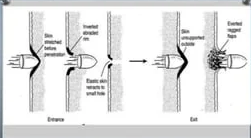Types of Ballistics in Forensic Science
What is Ballistics?
Ballistics is a branch of science that deals with the propulsion, flight, and impact of projectiles on the target. The term "Ballistics" finds its roots in the Greek word "Ballein," signifying "to throw" or "to project." It is Colonel Godard who first coined forensic ballistics. He used the systematic study of firearms and ammunition for investigation and justice.
Types of Ballistics
Ballistics is divided into three major types:
1. Internal Ballistics
Internal Ballistics is the branch of ballistics that deals with the study of the projectile inside the barrel of the firearm that is from when the firing pin hits the primer to the time the bullet exists the barrel from the muzzle end of the firearm.
It is also known as Initial or Interior Ballistics. Internal ballistics helps in linking the projectile with the firearm by studying scratch marks on the projectile, velocity of the projectile, defects in the barrel, Erratic behavior of projectiles, etc.
2. External Ballistics
External Ballistics is the branch of Ballistics that deals with the study of the projectile of the bullet when it leaves the barrel and when it is about to hit the target. Therefore, it studies the trajectory, velocity, range, time of flight, etc of the bullet. External Ballistics came into consideration when Internal Ballistics ended and Terminal Ballistics is about to start.
3. Terminal Ballistics
Terminal Ballistics is the branch of Ballistics that deals with the study of the behavior of a projectile/bullet when it hits the target. It is concerned with the study of penetration potential and wound ballistics. Terminal Ballistics start just after External ballistics get over.





